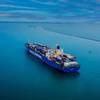ESS Saves Fuel for North Sea Construction Ship
One of the world’s largest and most advanced subsea construction vessels has been equipped with three energy storage systems (ESS), featuring for the first time ever energy and load sharing capability.
Finland based technology group Wärtsilä said the new system on board North Sea Shipping AS owned North Sea Giant combines a diesel-electric configuration with batteries, and is designed to deliver as much as 50 percent fuel savings in optimal operating conditions.
The installation was carried out in February 2018. In a second phase of the project, Wärtsilä commissioned an electronic bus link, a newly developed module that allows the ship to share load and energy optimally between the three Wärtsilä energy storage systems. This technology is expected to generate additional operating cost savings, and a total reduction in annual fuel consumption of two million liters, Wärtsilä said. The estimated annual reduction in exhaust emissions is 5.5 million kg of CO2, 30 tons of nitrogen oxides (NOx), and 1200 kg of sulphur oxides (SOx), ythe company added.
Sindre Utne, General Manager, Wärtsilä Project Centre, Norway, said, “This is a forward looking solution that offers both cost and environmental benefits, including less maintenance, reduced fuel consumption, and fewer exhaust emissions. In addition, it promotes more efficient and safer operations for the ship. We are confident that the positive impact of this solution will eventually be felt throughout the industry.”
Hallvard Klepsvik, CEO of North Sea Shipping AS, said, “The project has been driven by our focus on reducing the environmental impact of offshore oil-related operations in the North Sea. The advanced Wärtsilä energy storage system is important, because of both the favorable fuel consumption as well as its sustainability. Seabed installations are increasingly moving further north into very sensitive environmental areas, which makes this system extremely relevant.”
The three Wärtsilä energy storage systems reduce load fluctuations on the ship’s diesel generators. Typically, vessels utilizing dynamic positioning require two or more engines operating simultaneously at low load to secure back-up power. By using the Wärtsilä hybrid battery system to provide the needed reserve power, the operational engine can be run closer to its optimal load point.













